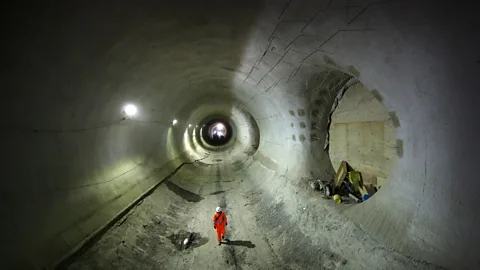An eerie drone flight under London’s streets
 Getty Images
Getty ImagesSit back and watch mesmerising footage of a drone flying through the Crossrail tunnels under London.
The view begins high above the London rooftops, the kind of eye-view usually seen only by crane operators working in cramped cabins. You descend at a gentle rate, dropping down until you’re at the level of the treetops and office buildings. And then further and further, towards the giant hole that has been dug yards from the busy street.
And then you descend into the hole itself, one which leads onto an enormous tunnel wider than a city street. Hard-hatted workers file through the tunnel, lit by bright industrial lights. It’s a tour of one of the world’s biggest engineering projects – filmed with a drone.
In the video above, released by Crossrail to mark the end of the project’s tunnelling phase, drone footage is cut with other rarely seen video of a train’s-eye-view of the tunnels.
Running at just under five minutes, it’s an eerie, almost calming, viewing experience – and there’s plenty to discover in the depths. See how eagle-eyed you are watching the video – can you spot the following?
* A workman taking a phonecall on a ‘bench’
* Jackets hanging on the tunnel wall
* Shadow of the drone
* Portable toilet
* Workman pretending to shoot the drone down
* Prefab office, complete with kettle
So how do you go about filming with a drone beneath the ground? The Crossrail footage follows similar material shot by the BBC earlier in the year.
BBC drone pilot John Bontoft, one of a handful of cameramen specially trained to use the technology, was the first person to shoot footage in the network’s tunnels and possibly one of the first to fly one in an underground railway tunnel anywhere in the world.
Despite the absence of a GPS signal 40m (135ft) beneath the ground, shooting footage in a tunnel is actually fairly simple, says Bontoft. “We were in an enclosed hermetically sealed environment – it’s probably the best place to fly a UAV.”
To shoot the BBC’s footage Bontoft used a DJI Phantom 2 quadcopter equipped with a Go Pro camcorder. Both systems are readily available off-the-shelf and a great deal cheaper than the previously used for such aerial footage.
Drones are increasingly used for BBC broadcasting – most recently, a news item on fracking. BBC transport producer Jonathan Sumberg, who is widely credited with pioneering the broadcaster’s use of the technology, says drones can provide a unique perspective impossible to achieve otherwise. “Used in the right circumstances it just puts the viewer somewhere a cameraman just can’t get,” he says.
 Getty Images
Getty ImagesIn the meantime Bontoft is thinking about where the technology might lead him next. “A rocket launch would be good, wouldn’t it. And I love the transition things – finding a way from going to air or water would be great. Or perhaps, staying on the tunnel theme, we could fly a drone through the Large Hadron Collider! They’d probably never let one down there, but that’d be quite something.”
You can see how the BBC filmed their footage here.
